Selinunte, what to see: 11 stops at the archaeological site
Selinunte is a piece of ancient Greece in the heart of western Sicily. Selinunte is located in the municipality of Castelvetrano, a small town in the province of Trapani that offers its visitors not only white beaches and crystal-clear waters, but also many places to see important traces of the past up close. The most famous is surely the great archaeological park of Selinunte, Cave di Cusa and Pantelleria. In this, which is one of the largest archaeological areas in Europe, one can literally walk through history. The origins of the city of Selinunte are traced back to the mid-7th century B.C. at the hands of settlers from Megara Hyblaea. The Selinuntines occupied strategic points in the future urban area and defined the limits of vast agricultural areas to be exploited. At the beginning of the 6th century B.C.E. the urban layout was rigorously realized through the construction of the road system that can still be observed today. In 409 B.C. the city was destroyed by the Carthaginians and then remained in their hands until the Roman conquest a century and a half later. The archaeological area today is a veritable treasure trove of finds with its spectacular temples, but also with what remains of the old quarters by observing them one can easily imagine what life was like in Selinunte at the time of its heyday. Here are eleven must-see stops on your visit to Selinunte.
1. The Acropolis
The Acropolis is surely the most resplendent jewel of Selinunte. Its construction dates back to the city’s origins in the 6th century BC. The design of the Acropolis has a trapezoidal shape with, in the northern part, a large stepped wall surrounded by walls formed by curtains of square blocks with a filling of rubble and punctuated by 5 towers and 4 gates. To the north, the Acropolis has fortifications dating from the early 4th century B.C., while at the height of the main entrance is the so-called Tower of Pollux, which was built in the 16th century against privateers. The first temples built on the Acropolis, those P and R, date from the first half of the 6th century B.C.E., but already by the middle of the century the main sanctuary building became Temple C with its large altar. Temples D, A and O were later added. Later, beginning in the 4th century B.C.E., the sacred areas were occupied by Punic dwellings, and a Carthaginian sanctuary arose in the pronaos of temple A. Before the abandonment of the city, southeast of Temple C, the small Temple B was built, noted for the polychromy of its architectural elements.
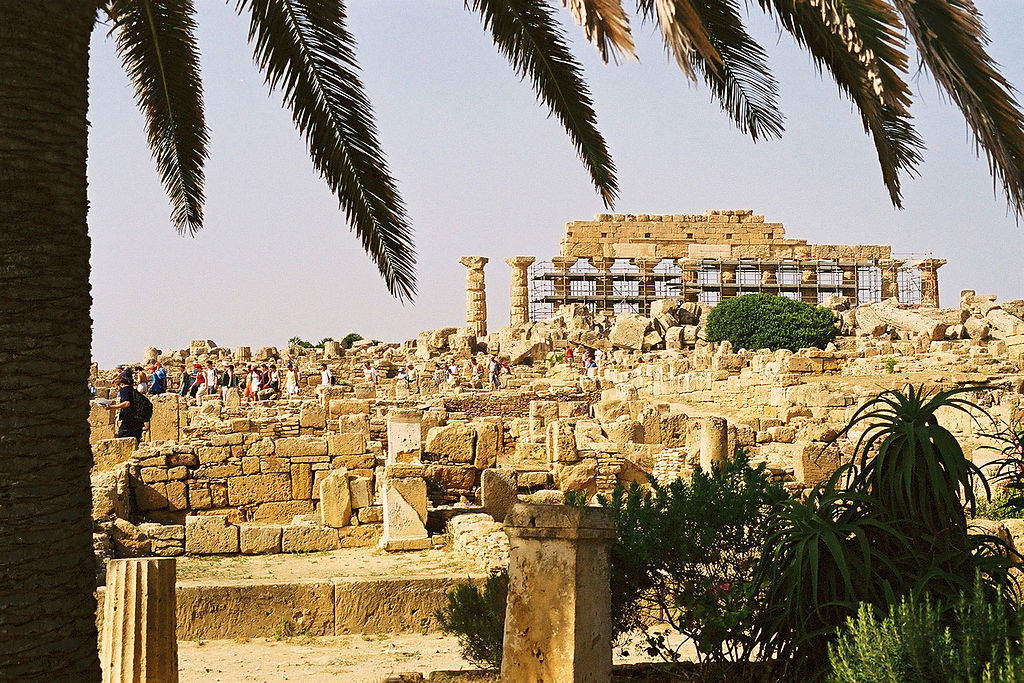
2. Temple A
According to archaeologists’ reconstructions, Temple A, built around the mid-5th century B.C., was certainly the most harmonious and refined temple in the city. Small in size, it had columns surrounding the cella in perfect symmetry, while the end of the cornice, the sima, was decorated with precious insular Greek marble and crowned the well-proportioned elevation. In the cella the entrance with the two columns is offset to the west by the similar opisthodomos. In contrast, the compartment for the worship statue is separate from the cella. Very elaborate elements are the two spiral staircases placed in the entrance wall to the cella: this is probably the first example of a spiral staircase in the history of architecture. Finally, the great altar echoed in a small way the forms of the Peripteral temple with its mensa, which was bordered by a colonnade with a Doric entablature and two pediments serving as cheeks. Only the side facing the temple was interrupted by a wide flight of steps, essential for worship services.
3. Temple C
The subject of major restoration work since the 1920s, Temple C is certainly one of the best known and most immortalized corners of Selinunte today. Temple C, also known as the Apollonion, was built around the mid-6th century B.C., with imposing dimensions and a second row of columns on the front. The main east side, where the entrance to the temple was located, housed in the pediment the famous painted terracotta Gorgon’s head, while the frieze contained the figurative reliefs of the metopes, now preserved in Palermo, depicting some famous episodes of Greek mythology such as the Quadriga of the Sun, Perseus slaying Medusa, and Heracles victorious over the Caecropes. The North Colonnade was raised between 1925 and 1927 and has undergone several restorations in recent years. Here, having passed the monumental entrance staircase, one enters a spacious portico divided in the center by four columns. In the center of the cella was a table for sacrifices and offerings, while the worship statue was inserted in the back compartment.
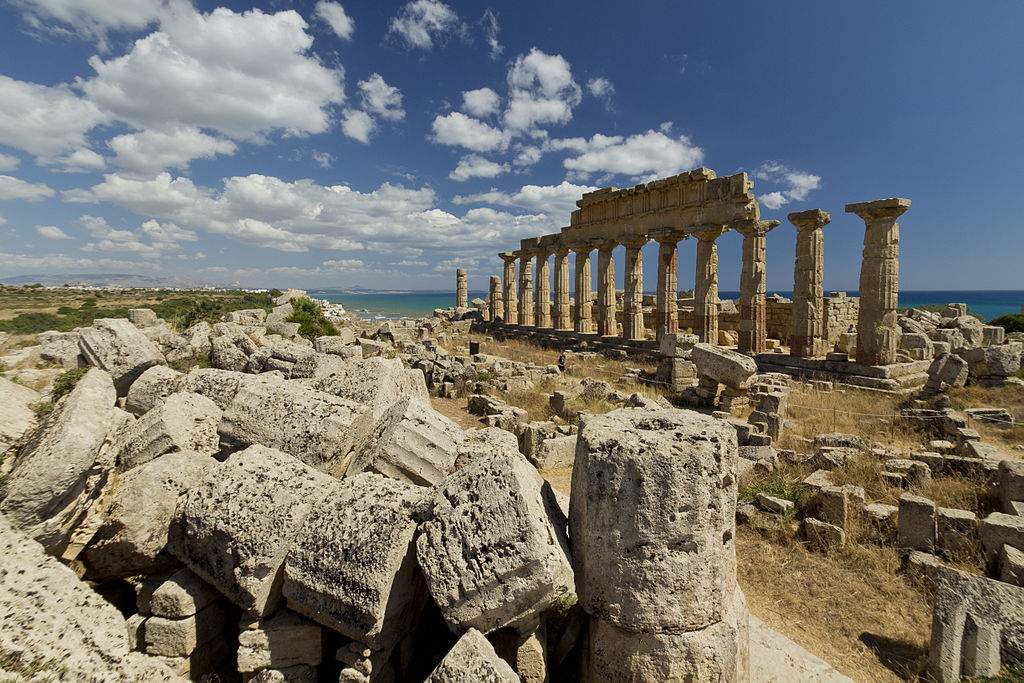
4. Temple D
Temple D dates from the last quarter of the sixth century BCE and is located immediately north of the large Temple C. Here The extension in length is reduced with the arrangement of only 13 columns on the long sides, while the second colonnade on the east side, characteristic of the Archaic age, is abolished and seems to merge with the front of the cella. Temple D was dedicated to Athena, and the large exterior altar, not on axis with the temple but placed obliquely suggests that the present Temple D occupies the site of an earlier one. In general, scholars consider Temple D more advanced than Temple C although even in these buildings some uncertainty in measurements is still evident. Like Temple C, D also shows in the floor of the peristyle and cella many circular or square cavities whose function is unknown. The building as a whole seems to represent a more evolved form of the peripteral temple of the Archaic period and lays the foundation for the forms of the Classical age
5. Temple E
Also known as the Heraion, its remains were unearthed in 1823 by two British archaeologists, Samuel Angele and William Harris, who tried in vain to bring the temple’s carved metopes to the British Museum. The Doric temples of the Eastern Hill suburban sanctuary, moreover, can be considered the city’s most prestigious cult buildings and represented the magnificence and power of the Megarian colony to all who sailed along this stretch of the Sicilian coast. At the time of discovery, the architecture of the sanctuary was in complete ruins, and the only part still standing was a portion of the cell wall. It remained in this state until the 1950s, when the temple was almost entirely rebuilt in a massive operation that brought the sanctuary to its present appearance. Temple E had rich polychrome finishes, some of which have been preserved, that characterized the temple’s architecture. In the cella, on the frieze of the short sides, were carved metopes, made of limestone with marble elements. Of the twelve total, only five remain, preserved at the Salinas Museum in Palermo.
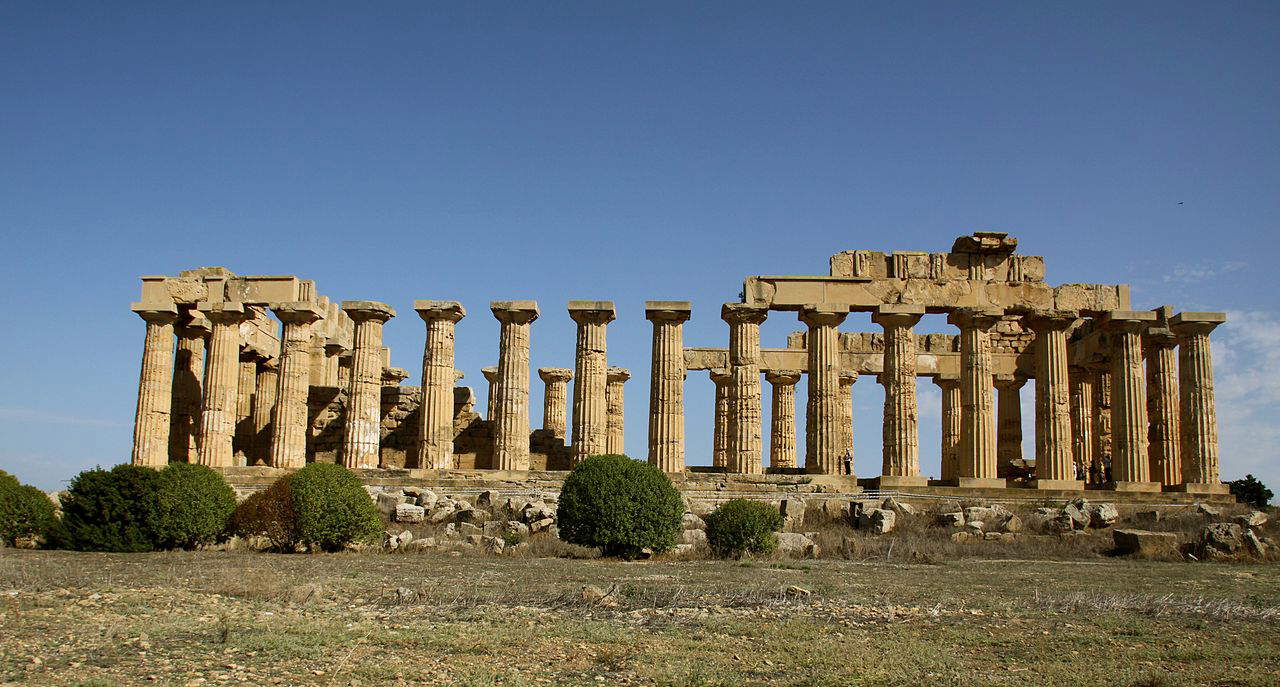
6. Temple F
Also very interesting is Temple F, a building of mature Archaic age that scholars believe may have been dedicated to Athena, Heracles, or Dionysus. What is certain is that this corner of the acropolis also retains a unique charm that can enrapture the visitor with echoes of the past. It is from here that two splendid fragments of metopes depicting episodes of the gigantomachy originate and are, like so many other finds unearthed in the archaeological area of Selinunte, preserved at the Salinas Museum in Palermo. Based on reconstructions and studies conducted on the entire area, researchers think that in Temple F an attempt was made to fit the narrow and long scheme of the traditional plan into a rectangle with less elongated proportions, a solution that resulted in an irregularity between the inner row of columns on the east side and the front of the cella. Later, the space between the columns of the peristasis was enclosed with transennas, more than a man’s height. Perhaps a security measure to achieve greater secrecy in the conduct of the cults.
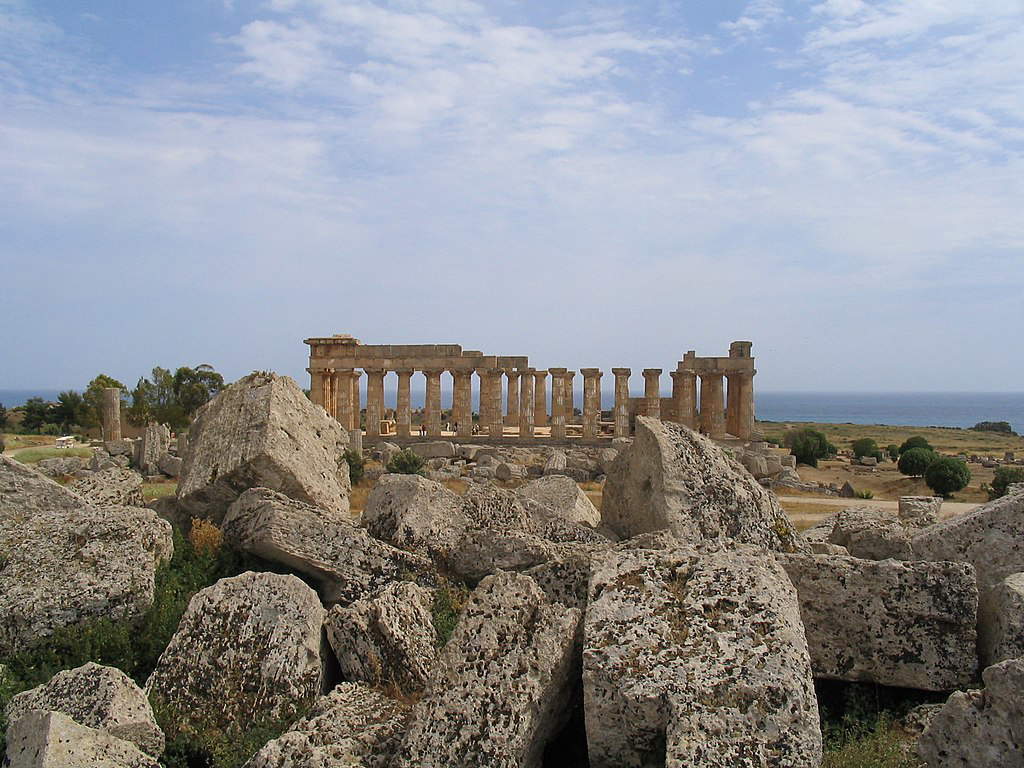
7. Temple G
Selinunte’s gitante: Temple G, also known as Olympieion, is one of the largest Doric sanctuaries in the Greek world. It owes the name Olympieion to the important inscription, better known as the Selinuntine Table, found in 1871 in the temple’s opisthodomos and now preserved at the Salinas Archaeological Museum in Palermo. This temple measured like a soccer field: it was 50 meters wide and 110 meters long with eight columns on the short sides and seventeen on the sides. Two rows of columns divided the cella into three naves culminating in a small temple where the cult statue was kept. Today, the colossal column known as the “Spindle of the Old Woman” emerges from the immense ruins of the building. The highly differentiated architectural forms of the temple, especially of the capitals hint at the long period of construction of the building, which is estimated to span about seventy-five years. Although many details were never completed, the temple appears to have been in use from at least the mid-5th century B.C. although researchers are still dubious about the destination of some sixty large column blocks planned for the temple but remaining in the Cave of Cusa.
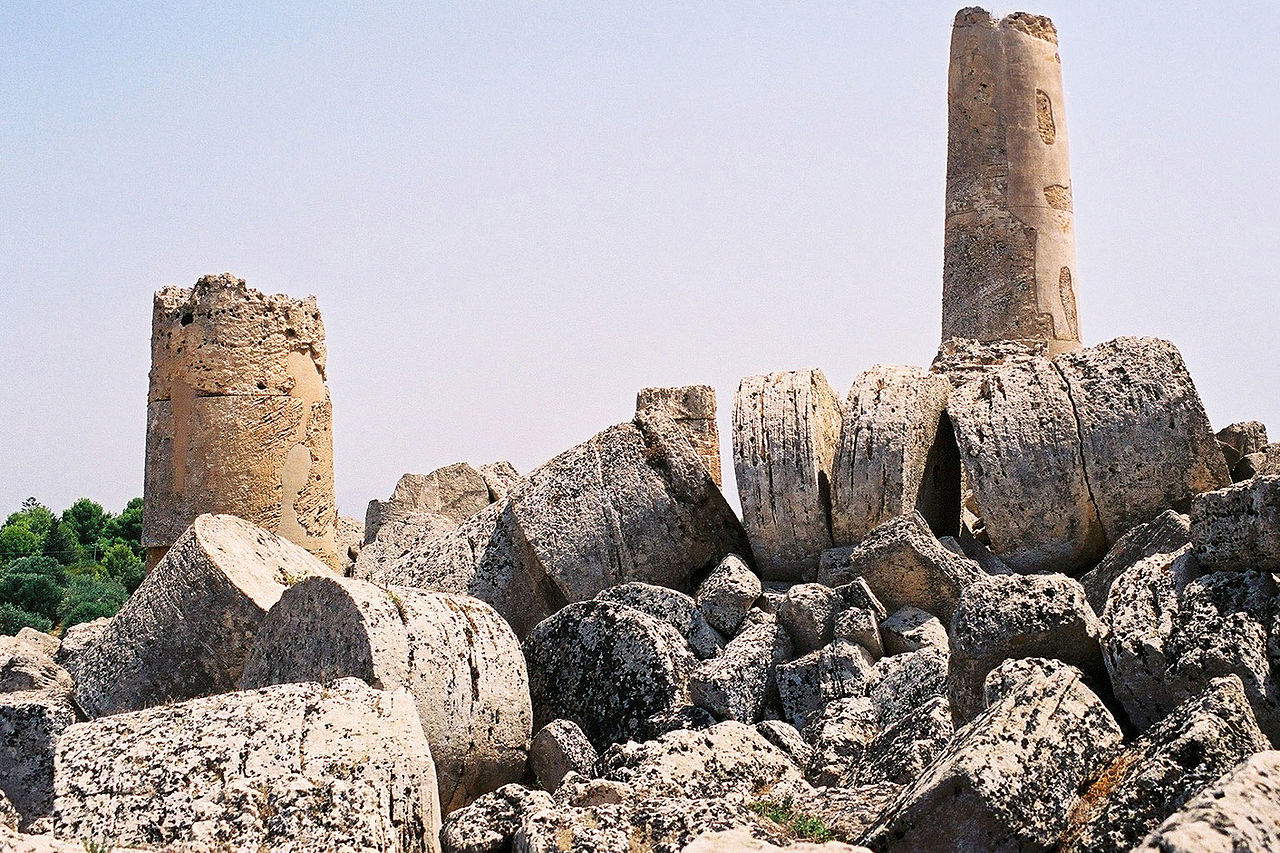
8. Sanctuary of Malophoros
One of the most fascinatingly endowed sites in the entire archaeological area of Selinunte is surely the extensive sanctuary of Malophoros in Contrada Gàggera. This demarcates, along with Temple M and the megaron of Hera to the south, the western limit of the city beyond the Modion River. The inner space of the sanctuary was divided into two large sacred areas. The larger and more important area, defined on three sides by high enclosure walls, was accessed through a monumental entrance. In contrast, a portico extended to the north d and a sacred enclosure to the south. The megaron of Malophoros was divided inside into three compartments while the chest altar held many of the archaic votive offer ings. A water channel, connected to the Gàggera spring, ran from north to south through the entire sanctuary, even beyond the surrounding walls. Then there was an area dedicated to Zeus Meilichios where the remains of two porticoes are still preserved.
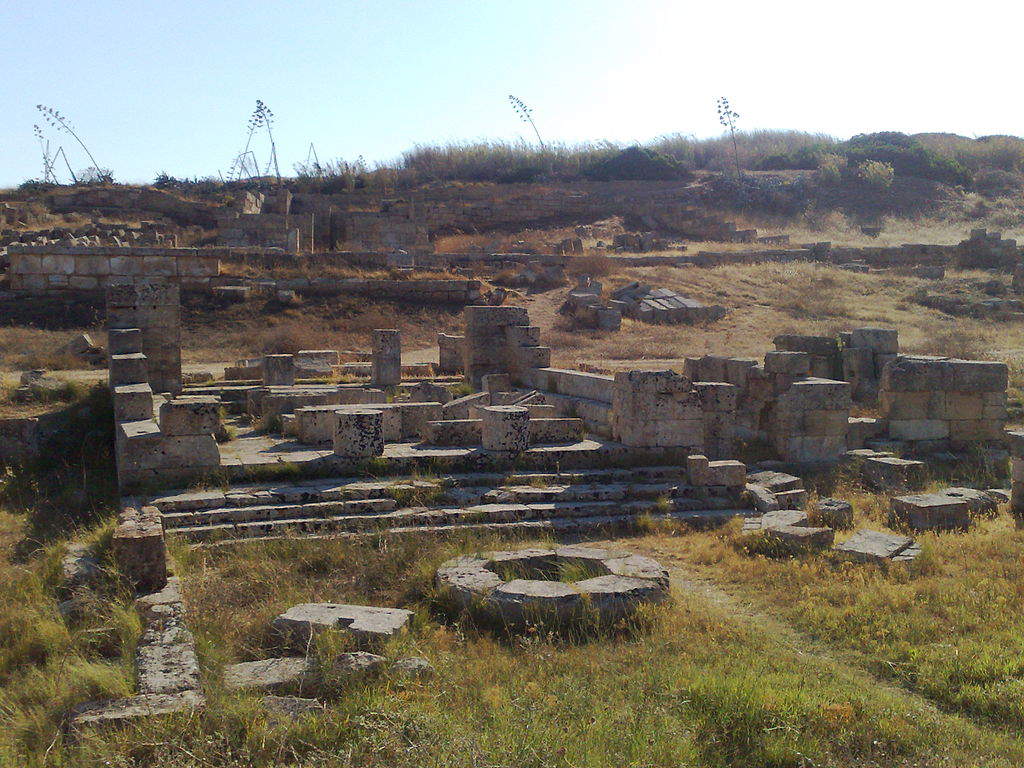
9. Necropolises
There are several necropolis located within the archaeological area of Selinunte. The most important was within the Acropolis, on the Manuzza Plateau, another was instead found north of the temples on the eastern hill in the so-called contrada Buffa, and to these are added a third in the area of the contrada Galera Bagliazzo and a fourth west of the Modione River further ahead of the sanctuary of Malaphóros, in the contrada Manicalunga Timpone. Numerous tombs have been found in all of these, from which come thousands of objects, mainly earthenware vases and figurines, which served to protect and accompany the deceased on their journey to the afterlife. Especially interesting is what has been found on the Manuzza plateau, a large area in which the 580 B.C. orthogonal-type urban layout constitutes one of the most interesting examples of colonial planning of the Archaic period.
10. Cave of Cusa
About 11 kilometers from the archaeological area of Selinunte lie, materially, the origins of the city. The Quarries of Cusa were the main quarrying site for the stones used in the construction of Selinunte’s buildings and temples. The rock of the Quarries of Cusa, which is very compact, was used from the first half of the 6th century B.C.E., only to be abandoned when mining was still in full swing, as evidenced by the column blocks being formed or already extracted for the construction of Temple G, at the time of the advance of Hannibal’s army in 409 B.C.E. Today their appearance is characterized by a long rock wall of extraction about 8 meters high that can be followed for about 1,700, while the current name and refers to Baron Cusa, former owner of the area. In the 16th century they were, however, known by the Arabic name of Ramuxara. The Selinuntines also obtained building stone from other quarries. Some of them, such as those located along the slopes of Manuzza, are within the city; others, such as the Barone Quarries, are about 4 kilometers north of Selinunte. Further afield are those at Misilbesi near Menfi, exploited mainly for sculpture work. From the Cave of Cusa the pieces Pieces were transported along a rocky road nine to ten meters wide that is no longer visible today.
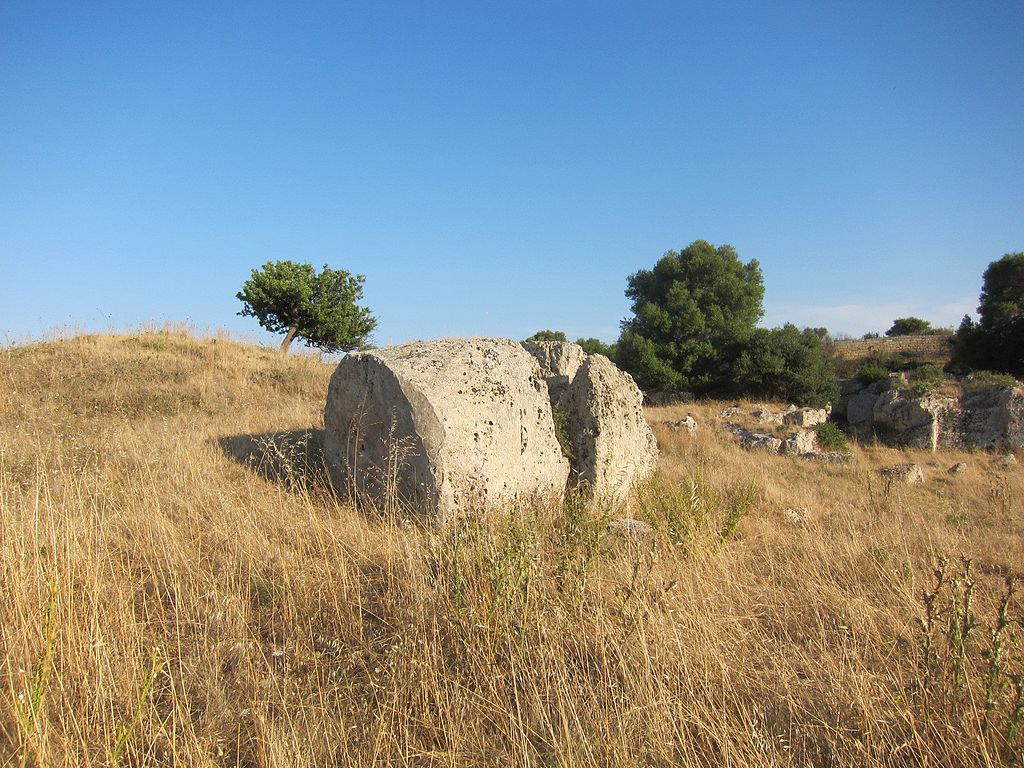
11. Manuzza plateau
Manuzza Hill was the area on which some of the first settlers settled. The linearity of the land and its vastness induced the settlers to choose as the site of settlement this area close to the Acropolis, to which it was adequately connected. Those same settlers divided the area into bands while the concrete boundary between urban space, necropolis and countryside was fixed later with the construction of the defense walls. From its origins, however, the urban layout of the plateau was characterized as a body that linked the Acropolis with the villages on its sides and the eastern hill. With the development of monumental buildings and great religious architecture, the landscape underwent a radical transformation: from a settlement with a rural character, it changed to an articulated urban landscape. In the center of the city, between the southern and northern districts, a large area was spared for the construction of the agora, a large square reserved for the public life of the city. All major roads converged on the square, and a funerary monument dedicated to the city’s founder was built almost in its center.
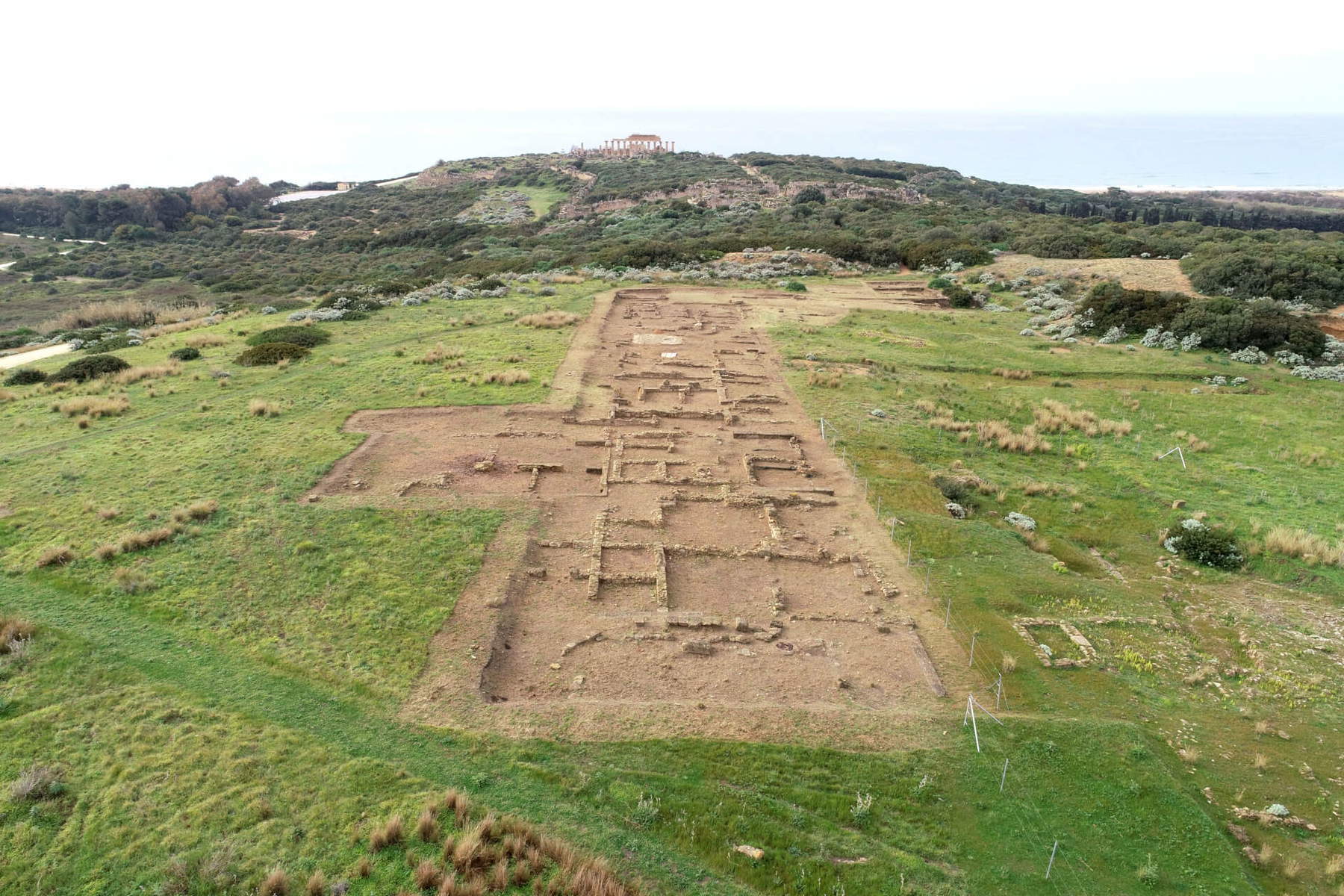
 |
| Selinunte, what to see: 11 stops at the archaeological site |
Warning: the translation into English of the original Italian article was created using automatic tools. We undertake to review all articles, but we do not guarantee the total absence of inaccuracies in the translation due to the program. You can find the original by clicking on the ITA button. If you find any mistake,please contact us.



























